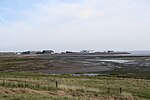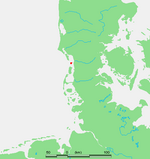Rømø Church
Buildings and structures in Tønder MunicipalityChurches in the Region of Southern DenmarkChurches in the diocese of RibeDanish building and structure stubsEuropean church stubs ... and 2 more
Lutheran churches converted from Roman CatholicismRømø

St. Clement's Church (Danish: Sankt Clemens Kirke) is a Christian place of worship located on the island of Rømø in Tønder, Denmark. It belongs to the Tønder Priory of the Church of Denmark. The church was dedicated to Saint Clement, the sailors' patron saint. The oldest part of the church was built sometime after 1250 and expanded four centuries later. Possibly in the latter half of the 15th century, the church tower was built in the Gothic style. The church was expanded in the 17th and 18th centuries. Interior decoration includes several votive ships.
Excerpt from the Wikipedia article Rømø Church (License: CC BY-SA 3.0, Authors, Images).Rømø Church
Havnebyvej, Tønder Municipality
Geographical coordinates (GPS) Address Phone number Website External links Nearby Places Show on map
Geographical coordinates (GPS)
| Latitude | Longitude |
|---|---|
| N 55.112958333333 ° | E 8.5426305555556 ° |
Address
Sankt Clemens Kirke (Rømø Kirke)
Havnebyvej
6792 Tønder Municipality
Region of Southern Denmark, Denmark
Open on Google Maps










